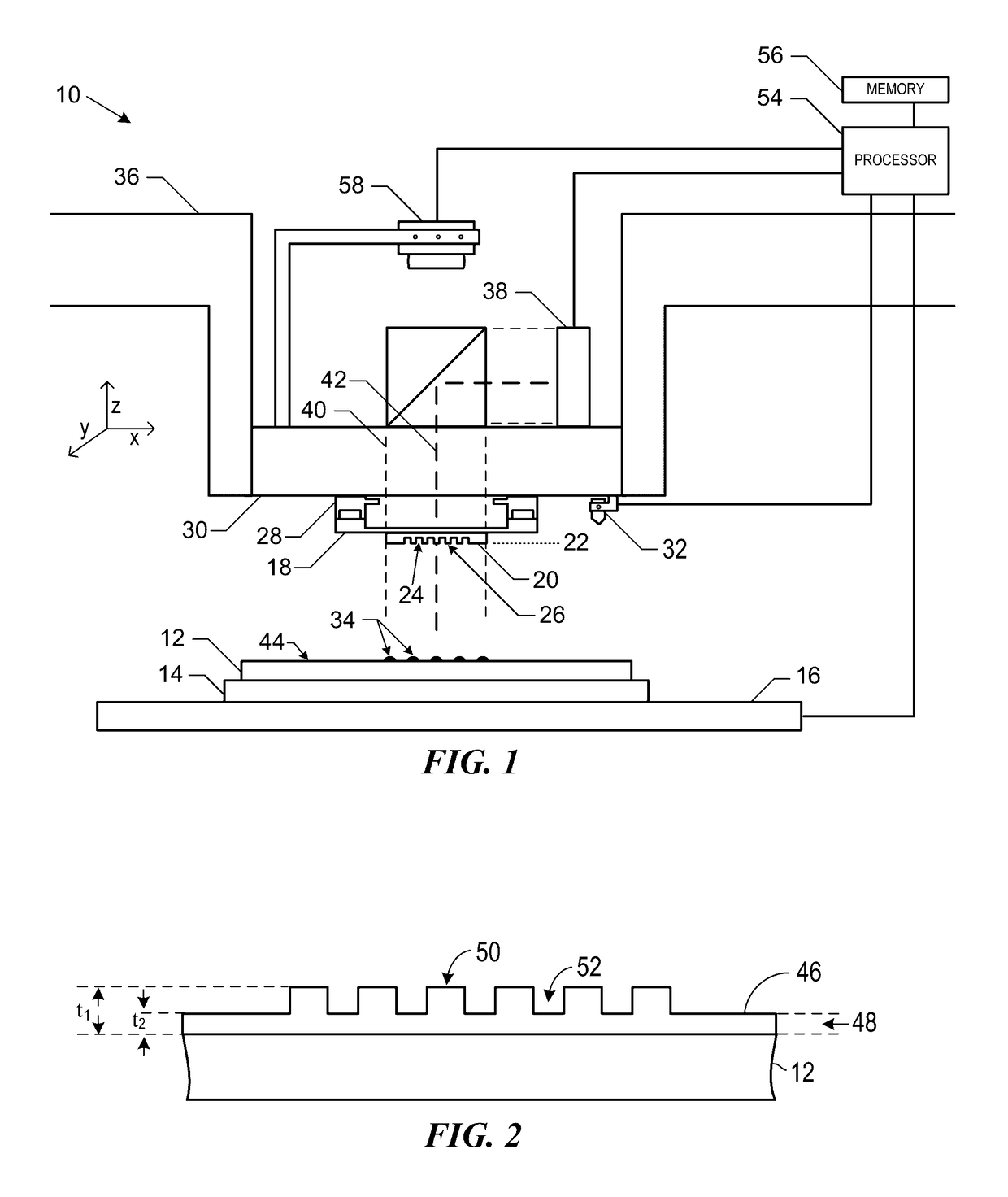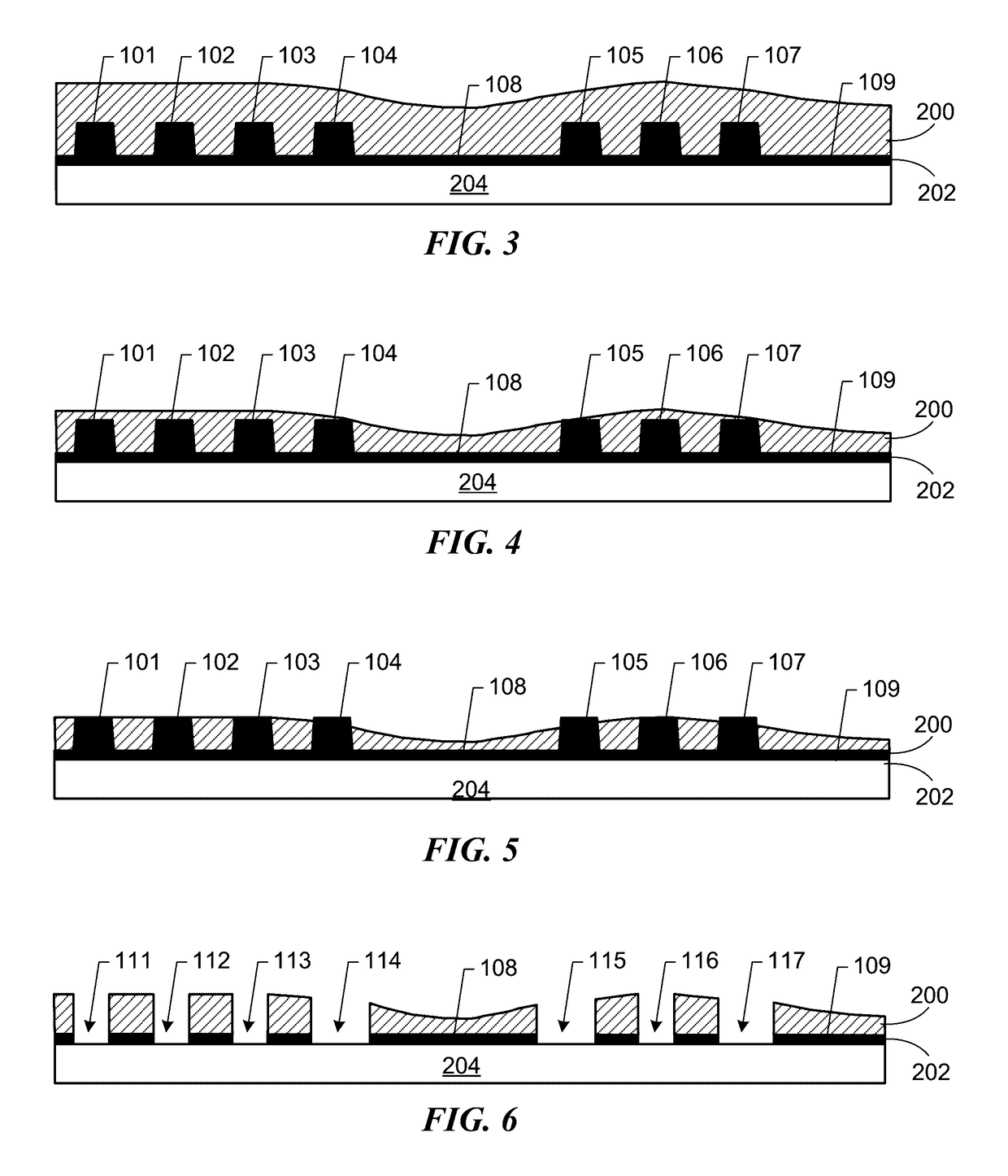Method of reverse tone patterning
a tone patterning and tone patterning technology, applied in the field of reverse tone patterning, can solve the problems of limited effectiveness of such processes, and achieve the effect of minimizing variability and enhancing critical dimension uniformity
- Summary
- Abstract
- Description
- Claims
- Application Information
AI Technical Summary
Benefits of technology
Problems solved by technology
Method used
Image
Examples
example 1
[0040]In a first example, the hard mask layer thickness that is etched away hHME=20 nm; the etch selectivity ξ2=5; the global variations of the protection layer thickness above the same type of feature, Δhprotect_global=3 nm, and global variations of the feature height, ΔFHglobal=2 nm, and the feature height, FH=40 nm. From here, equation (10) above becomes:
PEmin=1 / 40(20 / 5+3+2)=0.225=22.5% (11)
Thus with the above parameters, the minimum planarization efficiency of 22.5% for the protective layer is adequate to safely and completely reverse the pattern tone. Table 1 below shows PEmin values for the above given parameters but with different etch rates.
TABLE 1Relation between given etch selectivity, ξ2, and the required minimumplanarization efficiency according to equation (10) with remainingparameters constant.ξ2PEmin, %20151017.5620.8522.5425329.2237.5162.5
As shown, if the etch rate selectivity is very high, e.g., ξ2=10, the minimum planarization efficiency can be fairly low, e.g., P...
example 2
[0041]In this example, the variables remain the same as in Example 1 with the exception that the global variation of the protection layer thickness is increased to Δhprotect_global=10 nm. From here equation (10) above becomes:
PEmin=1 / 40(20 / 5+10+2)=0.4=40% (12)
Here, given the above parameters and chosen etch selectivity ξ2=5, the minimum planarization efficiency of 40% is enough to for the protective layer to safely and completely reverse the pattern tone. However, it can also be seen that non-ideal spin-on protection layer thickness variations of 10 nm are causing more stringent requirements for planarization efficiency. For ξ2=5, the minimum planarization efficiency is increased from 22.5% for Δhprotect_global=3 nm (in Example 1) to 40% for Δhprotect_global=10 nm in this example. Table 2 below shows PEmin values for the above given parameters but with different associated etch rate selectivity.
TABLE 2Example 2 relation between given etch selectivity, ξ2, and the requiredminimum pl...
example 3
[0042]In this example, the variables remain the same as in Example 1 with the exception that hard mask thickness is increased to hHME=30 nm. From here equation (10) above becomes:
PEmin=1 / 40(30 / 5+3+2)=0.275=27.5% (13)
Here, given the above parameters and chosen etch selectivity ξ2=5, the minimum planarization efficiency of 27.5% is enough to for the protective layer to safely and completely reverse the pattern tone. It is apparent that increased thickness of the hard mask (i.e., increased etch depth of the hard mask) causes more stringent requirements for minimum planarization efficiency. For ξ2=5 the minimum planarization efficiency is increased from 22.5% for hHME=20 nm (Example 1) to 27.5% for hHME=30 nm in this example. Table 3 shows PEmin values for the above given parameters but with different associated etch rate selectivity.
TABLE 3Example 3 relation between given etch selectivity, ξ2, and the requiredminimum planarization efficiency with remaining parameters constant.ξ2PEmin,...
PUM
 Login to View More
Login to View More Abstract
Description
Claims
Application Information
 Login to View More
Login to View More - R&D
- Intellectual Property
- Life Sciences
- Materials
- Tech Scout
- Unparalleled Data Quality
- Higher Quality Content
- 60% Fewer Hallucinations
Browse by: Latest US Patents, China's latest patents, Technical Efficacy Thesaurus, Application Domain, Technology Topic, Popular Technical Reports.
© 2025 PatSnap. All rights reserved.Legal|Privacy policy|Modern Slavery Act Transparency Statement|Sitemap|About US| Contact US: help@patsnap.com



